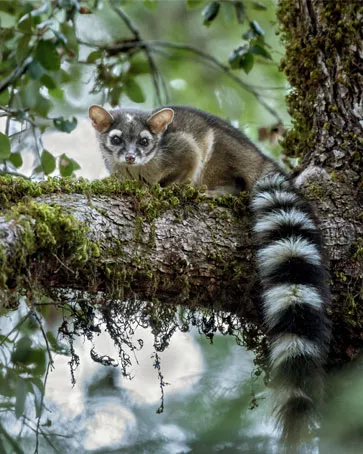Meet the Mysterious Ringtail
This desert dumpster diver is hard to spot

Photo By Drew Watson
I asked the ranger at Zion National Park where I might go after dark to see the elusive masked beasts—the ones that look like the love child of a raccoon and a lemur. I was picturing a moonlit trail framed by towering mountains of sandstone or a long walk to a quiet pool.
"Well," the ranger replied, "your best bet would be the garbage cans along the Riverside Walk."
If you consider ringtails' family relations, their taste for garbage is not a surprise. In evolutionary terms, ringtails are closely related to the raccoons that raid suburban trash bins. Like raccoons and many other members of the family Procyonidae, they have the dark eye markings and ringed tail whose evolutionary advantages are still under debate; the mask, at least, may be a warning to predators. Ringtails (Bassariscus astutus) prefer rocky habitats near water and have a range stretching across much of the southwestern United States and Mexico, with a few populations living as far north as Oregon. Their near-identical relative, the cacomistle, sticks to the tropical forests of Mexico and Central America. But they all play a similar role in the dark—scarfing up insects, fruit, mice, and frogs.
Given the right conditions, ringtails can be city dwellers like raccoons. One study found that ringtails thrive in Mexico City as long as they have shrubs as a source of food and shelter. Another recent study in Tlaxcala, one of the most densely populated states in Mexico, found that ringtails alter plant life around them because their tastes go far beyond trash. By eating native plants like juniper and prickly pear, ringtails give these species an ecological edge; the journey through a ringtail's digestive tract helps their seeds germinate and disperse across a region.
I staked out that trash pile in Zion until two in the morning. I saw a few mule deer. I heard some frogs. I saw no ringtails.
These animals aren't rare, and the International Union for Conservation of Nature lists ringtails and cacomistles as creatures of "least concern." They are just extremely good at hiding. It speaks to ringtails' stealthy abilities that I haven't seen one in over a decade of wandering the Four Corners. They navigate the darkness in a way we could only hope to. A reflective layer at the back of each eye allows them to see much better in low light than I can, meaning they can scram before I even get close. I may visit in the hours between dusk and dawn, but they live with the night in their bones.
The oldest Bassariscus fossils found so far are more than 13 million years old.
Ringtails are sometimes called cats because they groom their face, tail, and ears like domestic felines.
They might look cute and defenseless, but ringtails can eject an awful-smelling compound from their anal glands to menace would-be attackers.
 The Magazine of The Sierra Club
The Magazine of The Sierra Club







